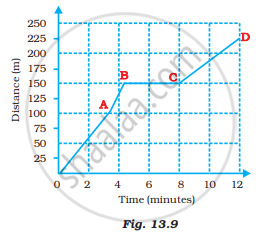Advertisements
Advertisements
प्रश्न
A spaceship is moving in space with a velocity of 60 kms−1. It fires its retro engines for 20 seconds and velocity is reduced to 55 kms−1. Calculate the distance travelled by a spaceship in 40 s, from the time of firing of the retro- rockets.
उत्तर
Initial velocity of spaceship = u = 60 kms−1
Final velocity of spaceship = v = 55 kms−1
It decelerates for 20 s
t = 20 s
v = u + at
55 = 60 + a (20)
20a = 55 – 60
20a = −5
a = `(-5)/20`
a = − 0.25
distance travelled in the first 20 sec. = s = u × t − `1/2` a × t2
s = 60 × 20 − `1/2` × 0.25 × 202
= 1200 − `1/2` × 0.25 × 400
= 1200 − `1/2` × 100
= 1200 − 50
= 1,150 km.
After 20 sec. the velocity of the spaceship is constant at 55 km/sec. Hence, the distance travelled is = 55 × 20 = 1,100 km
The total distance travelled in 40 sec. = 1,150 + 1,100 = 2,250 km
APPEARS IN
संबंधित प्रश्न
Show the shape of the distance-time graph for the motion in the following case:
A car moving with a constant speed.
Which of the following distance-time graphs shows a truck moving with speed which is not constant?
What can you say about the motion of a body whose distance-time graph is a straight line parallel to the time axis ?
A car is travelling at 20 m/s along a road. A child runs out into the road 50 m ahead and the car driver steps on the brake pedal. What must the car’s deceleration be if the car is to stop just before it reaches the child ?
A student draws a distance-time graph for a moving scooter and finds that a section of the graph is horizontal line parallel to the time axis. Which of the following conclusion is correct about this section of the graph?
Two students were asked to plot a distance-time graph for the motion described in Table A and Table B.
Table A
| Distance moved (m) | 0 | 10 | 20 | 30 | 40 | 50 |
| Time (minutes) | 0 | 2 | 4 | 6 | 8 | 10 |
Table B
| Distance moved (m) | 0 | 5 | 10 | 15 | 20 | 25 |
| Time (minutes) | 0 | 1 | 2 | 3 | 4 | 5 |

The graph given in Figure 13.2 is true for
If we denote speed by S, the distance by D and time by T, the relationship between these quantities is
Boojho goes to the football ground to play football. The distance-time graph of his journey from his home to the ground is given in Figure 13.9.

(a) What does the graph between points B and C indicate about the motion of Boojho?
(b) Is the motion between 0 to 4 minutes uniform or nonuniform?
(c) What is his speed between 8 and 12 minutes of his journey?
The area under velocity time graph represents ______.
The slope of the distance-time curve is steeper/greater is the ______.
